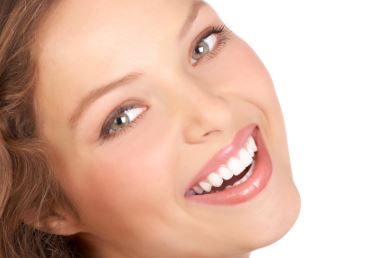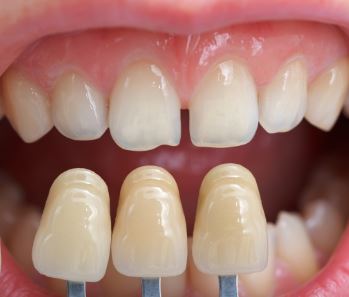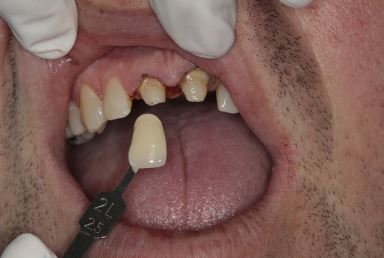 Achieve the Perfect Shade and Appearance for Restorations
Achieve the Perfect Shade and Appearance for Restorations
Patients achieve the highest levels of appearance match and satisfaction with restorations when they conduct a shade matching evaluation with a professional ceramic artist. DeLux in-house shade matching is the ideal choice.
When your Dentist Prescribes a Custom Shade Match
Because each patient is unique, sometimes the subtleties of matching crowns with natural teeth is best accomplished by meeting face to face with a ceramic artist.
A ceramic artist is a dental technician who works as part of the dentist’s team in
blending art and science to yield a pleasing outcome.
 Beyond just color, the patient’s intrinsic translucency, hue, value, chroma and texture are all assessed through the use of computerized tools, neutral lighting, color mapping, digital photography, 3D models, and advanced shade guide systems. The porcelain for your restoration is then custom blended, to transform the patient’s goals into reality.
Beyond just color, the patient’s intrinsic translucency, hue, value, chroma and texture are all assessed through the use of computerized tools, neutral lighting, color mapping, digital photography, 3D models, and advanced shade guide systems. The porcelain for your restoration is then custom blended, to transform the patient’s goals into reality.
Call 610-372-8496 to schedule an appointment!
Shade Appointment Features:
- Dedicated ceramic artist
- Industry best color systems
- Comprehensive analysis
- Convenient scheduling
- Expert preparation
Shade Appointment Benefits:
- Enhanced satisfaction
- Most accurate color
- Ideal translucency
- Ideal chroma
- Accurate Value
Preparing for a Shade Appointment with DeLux
Patients may come on their own to a shading appointment, with a companion, and if desired with their dentist.
 When you arrive at DeLux Laboratory you will be greeted by our friendly liaison and personally escorted to meet with your ceramic artist. We are confident that you will be pleased with the personalized service you receive.
When you arrive at DeLux Laboratory you will be greeted by our friendly liaison and personally escorted to meet with your ceramic artist. We are confident that you will be pleased with the personalized service you receive.
Patients should call ahead to confirm appointments, and upon arrival will be:
- Greeted by our friendly liaison
- Assisted with on-site parking
- Escorted to the appointment.
Patient tips for your successful visit to DeLux:
- Bleaching patients must wait seven days after the treatment before shading can be done.
- We recommend patients wear neutral colors and remove lipstick before shading.
- Appointments may take 20 minutes to an hour, so reserve enough time.
- Invite a friend or relative for a second opinion.
Dentist Tips for Shade Taking in Your Office
 When you and your staff perform shade-taking services in your own office, there are a number of things that will help you improve the speed, accuracy and final results of your work.
When you and your staff perform shade-taking services in your own office, there are a number of things that will help you improve the speed, accuracy and final results of your work.
- Before starting the shade taking process it’s important to talk to the patient to determine expectations.
- Teeth dehydrate VERY quickly, so take your shade FIRST before prepping teeth or taking impressions.
- Remove any lipstick.
- Use a neutral colored bib – gray, light blue or white.
- Sit patient upright and use ambient light (not direct light), preferably in a room with a window or color corrected lights.
- Hold entire shade guide to mouth and visually scan all tabs using process of elimination.
- Once selection is narrowed down, do not stare at tab for more than 10 seconds (the eye will compensate and everything will appear to match).
- If patient is bleaching, wait 2 weeks for color to stabilize prior to taking shade.
- Any photography is helpful! Even if you don’t have a camera, a picture taken on your smart phone (such as iPhone or Droid) is also an acceptable communication tool.
- Communicate to the laboratory if the patient has had endo or has dark underlying tooth structure after prepping. If so, pictures of the prep with a shade tab are also helpful.
- Characterization can be tricky! Let us know if the patient has a halo, tetracycline stains, hypocalcification, etc. and your shade will be even more lifelike.
Understanding Hue, Chroma and Value
- Hue is the basic color. Brown, Orange, Yellow, etc.
- Chroma is the intensity of that color, so that a higher degree of chroma would have a higher concentration of hue.
- Value, probably the most important factor, is rated as the amount of grayness or whiteness in a shade. A lower value means to darken and a higher value means to lighten or brighten.


 Delight Your Patients. Trust DeLux.
Delight Your Patients. Trust DeLux.